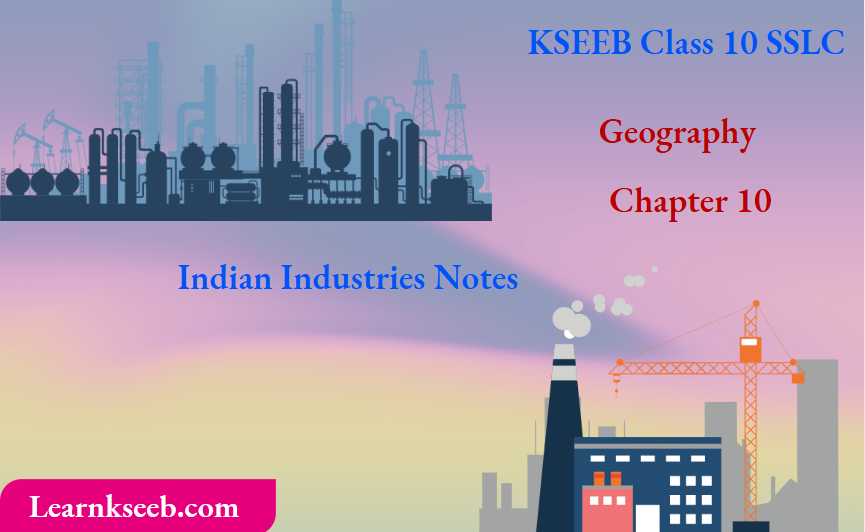KSEEB Class 10 SSLC Geography Chapter 10 Indian Industries Notes
The conversion of raw materials into usable products is known as ‘manufacturing industries’.
The localization and growth of industries are influenced by many factors-
- Supply of raw materials
- Supply of power
- Transport and communication facilities
- Market facilities
- Capital
- Labour and water supply
- Ideal climate and
KSEEB Class 10 SSLC Geography Chapter 10 notes
- Government policies
- In India, there are 8 major industrial regions.
- The modern iron and steel industry in India was started in 1874 at Kulti in West Bengal.
- However, the credit for modern iron and steel industry goes to J.N Tata who started the Tata Iron and Steel Company in 1907 at Sakchi (Jamshedpur).
- There are 14 integrated Iron and Steel plants in India. Of these, four are in the private sector and others are in the public sector.
Class 10 Geography Chapter 10 Indian Industries summary
In addition, there are 199 mini steel plants set up in different parts of the country.
- Aluminium is the most important non – ferrous metal. It has a wide range of uses.
- It was started in 1942 at Jayakaynagar in West Bengal. Now there are 9 major aluminium plants in the country.
- Cotton textile is the biggest and the most important branch of textile industry in India. It is the most important agro – based industry.
- The first modern cotton textile industry was started in 1854 when a cotton mill was set up at Mumbai.
Indian Industries SSLC Geography notes
Sugar industry is the second important agro – based industry in India, next only to cotton textiles.
- The modern sugar mills were started in the beginning of the 20th century.
- The art of paper making was introduced in India during 10th century. It was a cottage industry.
- The first modern paper mill was set up in 1932 at Serampur in West Bengal. But it was a failure.
- The real start was made in 1870 at Balley near Kolkata.
- The term “Knowledge based industries”, usually refer to those industries, which are relatively intensive in their inputs of technology and human education. They require intellectual capabilities rather than any physical inputs and raw materials.
- Information Technology (IT) is a key knowledge based industry.
- To encouraging the industry many software technology parks (STP) were established (1995) in different parts of the country.

KSEEB SSLC Class 10 Social Science Notes History
- Chapter 1 Advent of Europeans to India Notes
- Chapter 2 The Extension of the British Rule Notes
- Chapter 3 The Impact of British Rule in India Notes
- Chapter 4 Opposition to British Rule in Karnataka Notes
- Chapter 5 Social and Religious Reformation Movements Notes
- Chapter 6 The First War of Indian Independence (1857) Notes
- Chapter 7 Freedom Movement Notes
- Chapter 8 Era of Gandhi and National Movement Notes
- Chapter 9 Post Independent India Notes
- Chapter 10 The Political Developments of 20th Century Notes
KSEEB SSLC Class 10 Social Science Notes Political Science
- Chapter 1 The Problems of India and their Notes
- Chapter 2 Indian Foreign Policy Notes
- Chapter 3 India’s Relationship with Other Countries Notes
- Chapter 4 Global Problems and India’s Role Notes
- Chapter 5 International Institutions Notes
KSEEB SSLC Class 10 Social Science Notes Sociology
- Chapter 1 Social Stratification Notes
- Chapter 2 Labour Notes
- Chapter 3 Social Movements Notes
- Chapter 4 Social Problems Notes
KSEEB SSLC Class 10 Social Science Notes Geography
- Chapter 1 Indian Position and Extension Notes
- Chapter 2 Indian Physiography Notes
- Chapter 3 Indian Climate Notes
- Chapter 4 Indian Soils Notes
- Chapter 5 Indian Forest Resources Notes
- Chapter 6 Indian Water Resources Notes
- Chapter 7 Indian Land Resources Notes
- Chapter 8 Indian Mineral & Power Resources Notes
- Chapter 9 Indian Transport and Communication Notes
- Chapter 10 Indian Industries Notes
- Chapter 11 Indian Natural Disasters Notes
- Chapter 12 Indian Population Notes
KSEEB SSLC Class 10 Social Science Notes Economics
- Chapter 1 Development Notes
- Chapter 2 Rural Development Notes
- Chapter 3 Money and Credit Notes
- Chapter 4 Public Finance and Budget Notes
